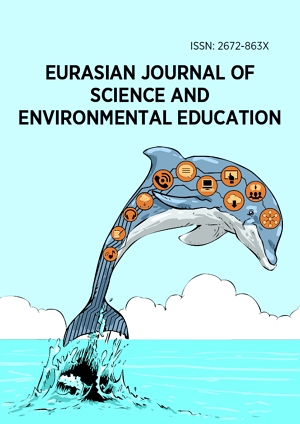Research Article
Critical thinking in national primary science curricula
More Detail
1 University of the Aegean, Mytilene, GREECE* Corresponding Author
Eurasian Journal of Science and Environmental Education, 3(2), December 2023, 51-60, https://doi.org/10.30935/ejsee/13271
Submitted: 14 March 2023, Published Online: 13 May 2023, Published: 01 July 2023
OPEN ACCESS 2958 Views 2686 Downloads
ABSTRACT
This research aims to identify elements of critical thinking that exist in primary science national curricula of several countries. Critical thinking is justified to be important in science teaching. It is considered a complex concept, which encompasses several skills. Science teaching is expected to promote the development and use of those competencies on behalf of the learners. The research around which of these elements are promoted in national curricula is still limited. Some models approach critical thinking as a concept comprised of five different groups of skills, which are basic clarification, decision, inference, advanced clarification and auxiliary skills. The model of Ennis was selected as appropriate for this study, which study examined the curricula of seventeen different countries. Through a content analysis approach, it investigated which of these groups and skills they mention. The data reveal that the majority of curricula refer to most of these skills.
CITATION (APA)
Karampelas, K. (2023). Critical thinking in national primary science curricula. Eurasian Journal of Science and Environmental Education, 3(2), 51-60. https://doi.org/10.30935/ejsee/13271
REFERENCES
- Byrne, M. S., & Johnstone, A. H. (1987). Critical thinking and science education. Studies in Higher Education, 12(3), 325-339. https://doi.org/10.1080/03075078712331378102
- Cohen, L., Manion, L., & Morrison, K. (2017). Research methods in education. Routledge. https://doi.org/10.4324/9781315456539
- Ennis, R. H. (1993). Critical thinking assessment. Theory into Practice, 32(3), 179-186. https://doi.org/10.1080/00405849309543594
- Ennis, R. H. (2018). Critical thinking across the curriculum: A vision. Topoi: An International Review of Philosophy, 37(1), 165-184. https://doi.org/10.1007/s11245-016-9401-4
- Forawi, S. A. (2016). Standard-based science education and critical thinking. Thinking Skills and Creativity, 20, 52-62. https://doi.org/10.1016/j.tsc.2016.02.005
- Harlen, W. (Ed.). (2010). Principles and big ideas of science education. Association for Science Education.
- Jones, A., Buntting, C., Hipkins, R., McKim, A., Conner, L., & Saunders, K. (2012). Developing students’ futures thinking in science education. Research in Science Education, 42(4), 687-708. https://doi.org/10.1007/s11165-011-9214-9
- Mai, M. Y. M., Yusuf, M., & Saleh, M. (2019). Content analysis for critical thinking skills in the lower primary school science textbooks in Malaysia. European Journal of Social Sciences Education and Research, 6(1), 83. https://doi.org/10.26417/ejser.v6i1.p83-91
- Muntaha, M., Masykuri, M., & Prayitno, B. A. (2021). Content analysis of critical-rand creative-thinking skills in middle-school science books on environmental pollution material. Journal of Physics: Conference Series, 1806(1), 012138. https://doi.org/10.1088/1742-6596/1806/1/012138
- OECD. (2013). PISA 2015 draft science framework. Organization for Economic Co-operation and Development. www.oecd.org/pisa/pisaproducts/pisa2015draftframeworks.htm
- Osborne, J. (2014). Teaching critical thinking? New directions in science education. School Science Review, 352, 53-62.
- Pithers, R. T., & Soden, R. (2000). Critical thinking in education: A review. Educational Research: A Review for Teachers and All Concerned with Progress in Education, 42(3), 237-249. https://doi.org/10.1080/001318800440579
- Santos Meneses, L. F. (2020). Critical thinking perspectives across contexts and curricula: Dominant, neglected, and complementing dimensions. Thinking Skills and Creativity, 35(100610), 100610. https://doi.org/10.1016/j.tsc.2019.100610
- Santos, L. F. (2017). The role of critical thinking in science education. Journal of Education and Practice, 8(20), 159-173.
- Schmaltz, R. M., Jansen, E., & Wenckowski, N. (2017). Redefining critical thinking: Teaching students to think like scientists. Frontiers in Psychology, 8, 459. https://doi.org/10.3389/fpsyg.2017.00459
- Snyder, L. G., & Snyder, M. J. (2008). Teaching critical thinking and problem solving skills. The Delta Pi Epsilon Journal, 1(2), 90-99.
- Sternberg, R. J. (1987). Teaching critical thinking: Eight ways to fail before you begin. Phi Delta Kappan, 68, 456-459.
- Thompson, C. (2011). Critical thinking across the curriculum: Process over output. International Journal of Humanities and Social Science, 1(9), 1-7.
- Vieira, R. M., & Tenreiro-Vieira, C. (2016). Fostering scientific literacy and critical thinking in elementary science education. International Journal of Science and Mathematics Education, 14(4), 659-680. https://doi.org/10.1007/s10763-014-9605-2
- Zemplén, G. Á. (2007). Conflicting agendas: Critical thinking versus science education in the international baccalaureate theory of knowledge course. Science & Education, 16(2), 167-196. https://doi.org/10.1007/s11191-006-6387-0

 The articles published in this journal are licensed under the CC-BY Creative Commons Attribution International License.
The articles published in this journal are licensed under the CC-BY Creative Commons Attribution International License.